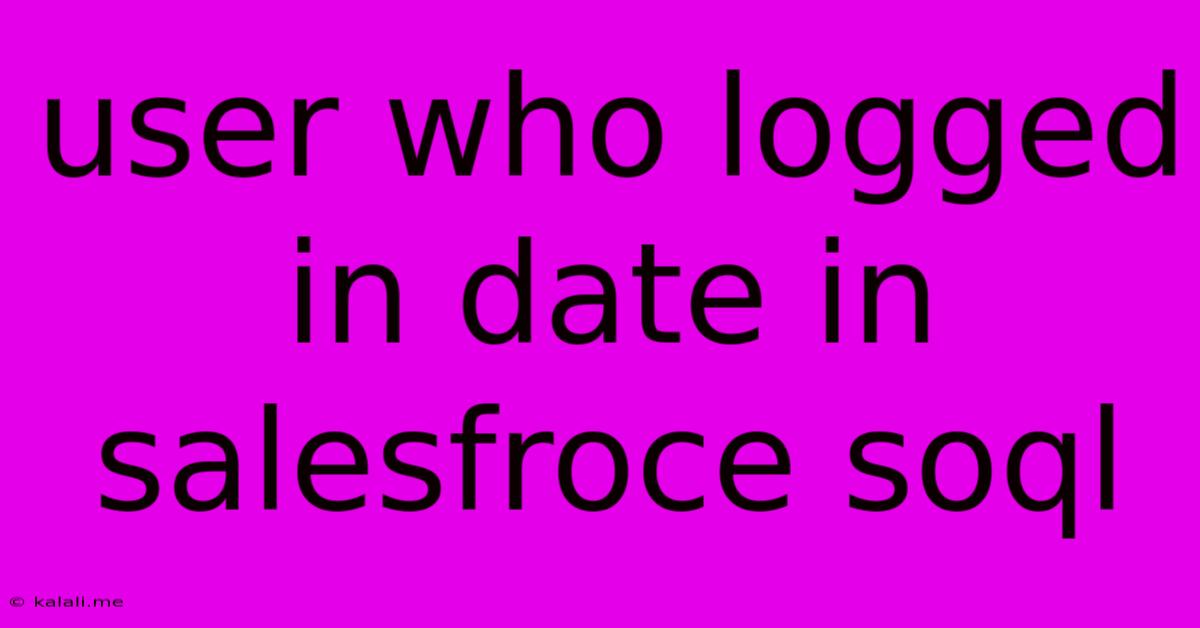User Who Logged In Date In Salesfroce Soql
Kalali
Jun 03, 2025 · 3 min read

Table of Contents
Getting the Last Login Date of a Salesforce User with SOQL
Finding the last login date of a Salesforce user is a common requirement for various administrative tasks and reporting needs. While there isn't a direct field for last login date on the User object, we can leverage the LoginHistory object to achieve this. This article will guide you through the process using SOQL (Salesforce Object Query Language). This information is crucial for security audits, user activity monitoring, and identifying inactive accounts.
Understanding the LoginHistory Object
The LoginHistory object stores a record for each user login. Crucially, it contains the LoginTime field which records the exact timestamp of each login. To find the latest login, we need to query this object and then filter for the most recent entry.
SOQL Query to Retrieve the Last Login Date
Here's the SOQL query you can use to find the last login date for a specific user:
SELECT LoginTime FROM LoginHistory WHERE UserId = '005xxxxxxxxxxxxxxxxx' ORDER BY LoginTime DESC LIMIT 1
Replace '005xxxxxxxxxxxxxxxxx' with the actual 18-character Salesforce ID of the user you're interested in. This query does the following:
SELECT LoginTime: This selects only the login timestamp, making the query efficient.FROM LoginHistory: This specifies the object we're querying.WHERE UserId = '005xxxxxxxxxxxxxxxxx': This filters the results to only include login history for the specified user ID.ORDER BY LoginTime DESC: This sorts the results in descending order by login time, placing the most recent login first.LIMIT 1: This restricts the results to only the first (most recent) login record.
Retrieving the Last Login Date for Multiple Users
If you need to retrieve the last login date for multiple users, you'll need a slightly more complex query. This approach requires using aggregate functions within a subquery:
SELECT u.Name, MAX(lh.LoginTime) lastLogin
FROM User u
LEFT JOIN LoginHistory lh ON u.Id = lh.UserId
GROUP BY u.Id, u.Name
This query:
SELECT u.Name, MAX(lh.LoginTime) lastLogin: Selects the user's name and the maximum (latest) login time, aliased aslastLogin.FROM User u LEFT JOIN LoginHistory lh ON u.Id = lh.UserId: Performs aLEFT JOINbetween theUserandLoginHistoryobjects to include all users, even those without login history.GROUP BY u.Id, u.Name: Groups the results by user ID and name to get the maximum login time for each user.
Important Considerations:
- API Limits: Be mindful of Salesforce API governor limits. If you're querying a large number of users, consider using batch Apex for better performance.
- Data Security: Ensure you have the appropriate permissions to access the
LoginHistoryobject. This usually requires administrator-level access. - Inactive Users: Users who have never logged in will not have entries in the
LoginHistoryobject. TheLEFT JOINapproach handles this gracefully by returningNULLfor thelastLoginfield for such users. - Data Freshness: Remember that the
LoginHistorydata reflects the user's past login activity. It is not a real-time indicator of the user's current online status.
By using these SOQL queries, you can effectively retrieve the last login date for Salesforce users, enabling robust user activity tracking and security management. Remember to adapt the queries to your specific needs and context, always considering performance and data security best practices.
Latest Posts
Latest Posts
-
How Do I Get Rid Of Tea Stains In Cups
Jun 05, 2025
-
Teenage Mutant Ninja Turtles In A Half Shell
Jun 05, 2025
-
Parents Punish Me But Wont Punish Brother
Jun 05, 2025
-
How To Plant An Oak Acorn
Jun 05, 2025
-
How To Exit Crontab With Saving
Jun 05, 2025
Related Post
Thank you for visiting our website which covers about User Who Logged In Date In Salesfroce Soql . We hope the information provided has been useful to you. Feel free to contact us if you have any questions or need further assistance. See you next time and don't miss to bookmark.